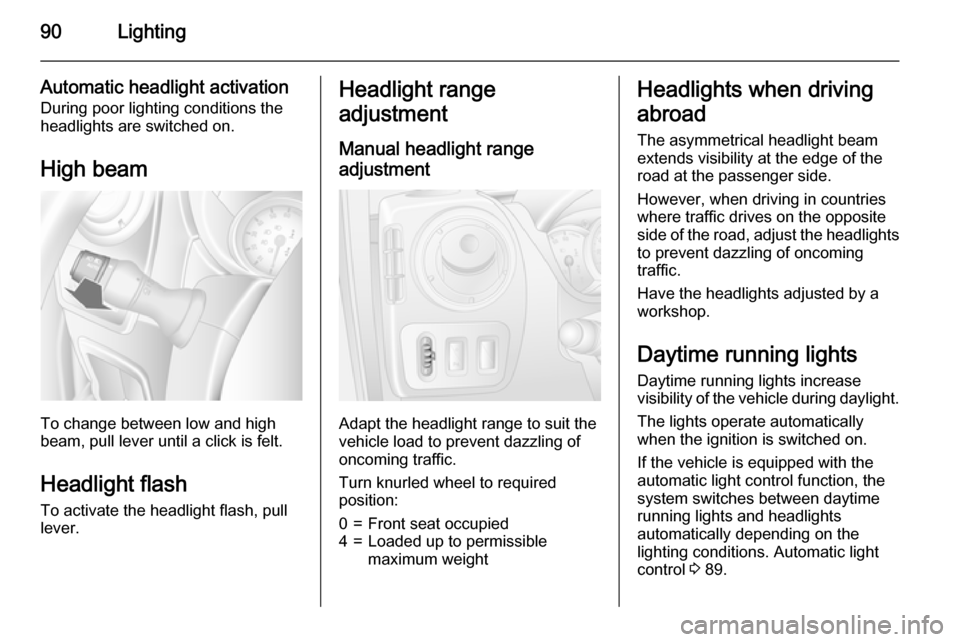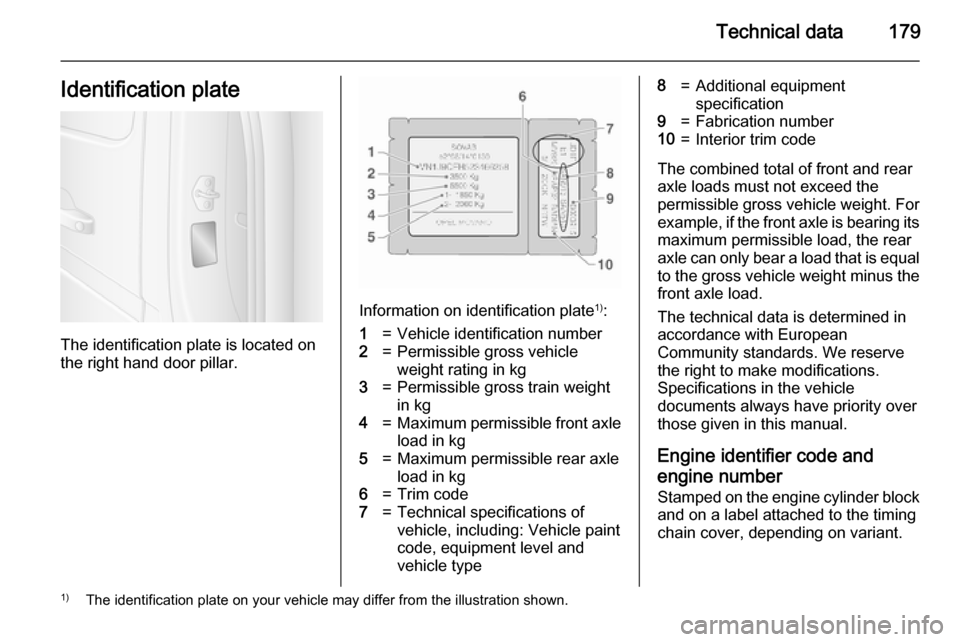Page 92 of 209

90Lighting
Automatic headlight activation
During poor lighting conditions the
headlights are switched on.
High beam
To change between low and high
beam, pull lever until a click is felt.
Headlight flash To activate the headlight flash, pull
lever.
Headlight range
adjustment
Manual headlight range
adjustment
Adapt the headlight range to suit the
vehicle load to prevent dazzling of
oncoming traffic.
Turn knurled wheel to required position:
0=Front seat occupied4=Loaded up to permissible
maximum weightHeadlights when driving
abroad
The asymmetrical headlight beam
extends visibility at the edge of the
road at the passenger side.
However, when driving in countries
where traffic drives on the opposite
side of the road, adjust the headlights to prevent dazzling of oncoming
traffic.
Have the headlights adjusted by a
workshop.
Daytime running lights
Daytime running lights increase
visibility of the vehicle during daylight.
The lights operate automatically
when the ignition is switched on.
If the vehicle is equipped with the automatic light control function, the
system switches between daytime
running lights and headlights
automatically depending on the
lighting conditions. Automatic light
control 3 89.
Page 134 of 209

132Driving and operatingFuel consumption - CO2-
Emissions
For the values specific to your
vehicle, refer to the EEC Certificate of
Conformity provided with your vehicle
or other national registration
documents.
General information
The official fuel consumption and
specific CO 2 emission figures quoted
relate to the EU base model with
standard equipment.
Fuel consumption data and CO 2
emission data are determined
according to regulation
715/2007 692/2008 A, taking into
consideration the vehicle weight in
running order, as specified by the
regulation.
The figures must not be taken as a
guarantee for the actual fuel
consumption of a particular vehicle.
Additional equipment may result in
slightly higher results than the stated
consumption and CO 2 figures.Furthermore, fuel consumption is
dependent on personal driving style
as well as road and traffic conditions.Trailer hitch
General information
Only use towing equipment that has
been approved for your vehicle.
Entrust fitting of towing equipment at
a later date to a workshop. It may be
necessary to make changes that
affect the cooling system, heat
shields or other equipment.
Driving characteristics and
towing tips In the case of trailers with brakes,
attach the breakaway stopping cable.
Before attaching a trailer, lubricate
the coupling ball. However, do not do so if a stabiliser, which acts on thecoupling ball, is being used to reduce
snaking movements. For trailers with
low driving stability the use of a
stabiliser is recommended.
A maximum speed of 50 mph must
not be exceeded, even in countries
where higher speeds are permitted.
Page 135 of 209

Driving and operating133
If the trailer starts snaking, drive moreslowly, do not attempt to correct the
steering and brake sharply if
necessary.
When driving downhill, drive in the
same gear as if driving uphill and
drive at a similar speed.
Adjust tyre pressure to the value
specified for full load 3 198.
Trailer towing Trailer loads
The permissible trailer loads are
vehicle-dependent and engine-
dependent maximum values which
must not be exceeded. The actual
trailer load is the difference between
the actual gross weight of the trailer
and the actual coupling socket load
with the trailer coupled.
The permissible trailer loads are
specified in the vehicle documents. In general, they are valid for gradients
up to max. 12 %.
The permitted trailer load applies up to the specified incline and up to an
altitude of 1000 metres above sealevel. Since engine power decreases as altitude increases due to the airbecoming thinner, therefore reducing
climbing ability, the permissible gross
train weight also decreases by 10 % for every 1000 metres of additional
altitude. The gross train weight does
not have to be reduced when driving on roads with slight inclines (less than 8 %, e.g. motorways).
The permissible gross train weight
must not be exceeded. This weight is
specified on the identification plate
3 179.
Vertical coupling load
The vertical coupling load is the load
exerted by the trailer on the coupling
ball. It can be varied by changing the
weight distribution when loading the
trailer.
The maximum permissible vertical
coupling load is specified on the
towing equipment identification plate
and in the vehicle documents. Always aim for the maximum load, especially
in the case of heavy trailers. The
vertical coupling load should never
fall below 25 kg.In the case of trailer loads of
1200 kg or more, the vertical coupling load should not be less than 50 kg.
Rear axle load When the trailer is coupled and the
towing vehicle fully loaded (including
all occupants), the permissible rear
axle load (see identification plate or
vehicle documents) must not be
exceeded.
Towing equipmentCaution
When operating without a trailer,
remove the coupling ball bar.
Towing equipment audible
warning For vehicles fitted with towing
equipment, when connected to a
trailer the pitch of the audible warning
changes upon operation of the turn
signals.
Page 181 of 209

Technical data179Identification plate
The identification plate is located on
the right hand door pillar.
Information on identification plate 1)
:
1=Vehicle identification number2=Permissible gross vehicle
weight rating in kg3=Permissible gross train weight
in kg4=Maximum permissible front axle load in kg5=Maximum permissible rear axle
load in kg6=Trim code7=Technical specifications of
vehicle, including: Vehicle paint
code, equipment level and
vehicle type8=Additional equipment
specification9=Fabrication number10=Interior trim code
The combined total of front and rear
axle loads must not exceed the
permissible gross vehicle weight. For
example, if the front axle is bearing its
maximum permissible load, the rear
axle can only bear a load that is equal
to the gross vehicle weight minus the front axle load.
The technical data is determined in
accordance with European
Community standards. We reserve
the right to make modifications.
Specifications in the vehicle
documents always have priority over
those given in this manual.
Engine identifier code and engine number Stamped on the engine cylinder block
and on a label attached to the timing
chain cover, depending on variant.
1) The identification plate on your vehicle may differ from the illustration shown.
Page 186 of 209
184Technical dataVehicle weight
Kerb weight, basic model without any optional equipment Optional equipment and accessories increase the kerb weight.ModelDrive wheelsLengthRoof heightGross vehicle weightKerb weight 3)4)VanFront-wheel driveL1H1280018063300181135001816H2280018343300183935001844L2H23300188535001890H33300192135001931L3H235001970H3350020103)
Kerb weight and gross vehicle weight increase on models fitted with bad road equipment package - refer to identification plate.
4) Minimum vehicle weight according to type approval, including all fluids, vehicle tools and a 90% fuel load. Excludes the weight of the driver and deletable
options, e.g. spare wheel, bulkhead and sliding side door. Final weight may vary according to the specification of the vehicle, e.g. options, deleted options
and accessories.
Page 187 of 209
Technical data185
ModelDrive wheelsLengthRoof heightGross vehicle weightKerb weight3)4)VanRear-wheel driveL3H235005)211035006)224645002246H33500 5)214835006)227945002279L4H23500 5)-7)3500 6)232445002324H335005)-7)3500 6)2366450023663)
Kerb weight and gross vehicle weight increase on models fitted with bad road equipment package - refer to identification plate.
4) Minimum vehicle weight according to type approval, including all fluids, vehicle tools and a 90% fuel load. Excludes the weight of the driver and deletable
options, e.g. spare wheel, bulkhead and sliding side door. Final weight may vary according to the specification of the vehicle, e.g. options, deleted options
and accessories.
5) With Single rear wheels.
6) With Twin rear wheels.
7) Figure not available at time of printing. Refer to identification plate on the right hand door pillar.
Page 188 of 209

186Technical data
ModelDrive wheelsLengthRoof heightGross vehicle weightKerb weight3)4)Platform CabFront-wheel driveL1H135001570L2H135001578H235001593L3H135001599H2350016133)
Kerb weight and gross vehicle weight increase on models fitted with bad road equipment package - refer to identification plate.
4) Minimum vehicle weight according to type approval, including all fluids, vehicle tools and a 90% fuel load. Excludes the weight of the driver and deletable
options, e.g. spare wheel, bulkhead and sliding side door. Final weight may vary according to the specification of the vehicle, e.g. options, deleted options
and accessories.ModelDrive wheelsLengthRoof heightGross vehicle weightKerb weight 3)4)Chassis CabFront-wheel driveL2H135001686L3H1350017073)
Kerb weight and gross vehicle weight increase on models fitted with bad road equipment package - refer to identification plate.
4) Minimum vehicle weight according to type approval, including all fluids, vehicle tools and a 90% fuel load. Excludes the weight of the driver and deletable
options, e.g. spare wheel, bulkhead and sliding side door. Final weight may vary according to the specification of the vehicle, e.g. options, deleted options
and accessories.
Page 189 of 209

Technical data187
ModelDrive wheelsLengthRoof heightGross vehicle weightKerb weight3)4)Chassis CabRear-wheel driveL2H135005)1835L3H135005)18603500 6)197545006)1975L4H13500 6)200545006)20053)
Kerb weight and gross vehicle weight increase on models fitted with bad road equipment package - refer to identification plate.
4) Minimum vehicle weight according to type approval, including all fluids, vehicle tools and a 90% fuel load. Excludes the weight of the driver and deletable
options, e.g. spare wheel, bulkhead and sliding side door. Final weight may vary according to the specification of the vehicle, e.g. options, deleted options
and accessories.
5) With Single rear wheels.
6) With Twin rear wheels.ModelDrive wheelsLengthRoof heightGross vehicle weightKerb weight 3)4)Crew CabFront-wheel driveL2H135001887L3H1350019153)
Kerb weight and gross vehicle weight increase on models fitted with bad road equipment package - refer to identification plate.
4) Minimum vehicle weight according to type approval, including all fluids, vehicle tools and a 90% fuel load. Excludes the weight of the driver and deletable
options, e.g. spare wheel, bulkhead and sliding side door. Final weight may vary according to the specification of the vehicle, e.g. options, deleted options
and accessories.